Celebrating its 20th anniversary, the Advanced Maui Optical and Space Surveillance Technologies Conference (AMOS) brought together a record-breaking 919 participants from 18 countries, the largest attendance in its history, at the Wailea Beach Resort-Marriott, Maui. The event, presented by the Maui Economic Development Board (MEDB), is the premier technical conference in the nation devoted to Space Situational Awareness (SSA) and Space Traffic Management (STM).
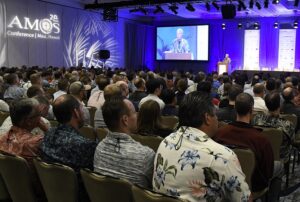
Gen Shelton introduces the keynote speakers on Day 1 of the 2019 AMOS Conference
Keynotes and panel discussions focused on improving SSA and STM to enable a rapidly growing commercial space economy while ensuring the safety, security, reliability, and operational sustainability of outer space to benefit all nations. Attendees discussed the critical nature of space safety, and focused on the need to mitigate the risk of collision or interference between satellites. As the situation becomes more urgent and the need for collaborative sustainability grows, governmental space policy, business incentives, and special technical requirements may all be needed to enhance space sustainability.
“Discussions included views on effective international cooperation in space and the long-term sustainability of the space environment,” said Leslie Wilkins, MEDB President and CEO. “With the advent of mega-constellations, the total number of space objects is likely to double within the next decade. This will increase the probability of collisions, making our normal daily life vulnerable to any disruption in the functioning of satellites.”
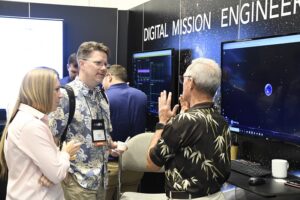
There were 26 Exhibitors at the 20th AMOS Conference
In addition to the technical sessions, the AMOS Conference included keynote speakers, policy forums, exhibit and poster sessions, technical short courses, networking events, the second annual EMER-GEN™ program, Best Paper Award, Best Student Paper Award, and Best Presenter Award in each technical session.
AMOS attracted nearly 200 technical papers this year with authors from 16 countries. The papers were reviewed and sorted into oral and poster presentations. The relevant technical papers will be considered for publication in the American Astronautical Society’s (AAS) Journal of Astronautical Sciences, for the second year.
In 2017, the AAS Space Surveillance Technical Committee, in partnership with MEDB, initiated the peer review process and publication of the selected papers which present significant new results, important insights, and state of the art surveys in all areas of astrodynamics, celestial mechanics, and space-related sciences.
“Peer review of select conference papers furthers the AMOS Conference’s standing as the lead technical conference in the area of SSA and provides a reference point for researchers working in the SSA and STM fields, “ said AAS SSTC member Robert Lauchie Scott, a Defence Scientist with Defence Research & Development, Canada. “We look forward to publishing the leading technical papers from AMOS with a view toward promoting the newest technologies, techniques, and practices ensuring the security and sustainable use of our Earth’s orbital resource.”
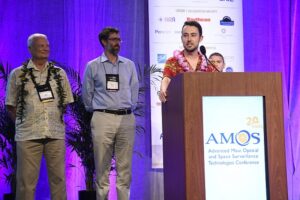
James Blake accepts the AMOS 2019 Best Student Paper Award
Awarded to the best manuscript submitted and presented by a student, the 2019 AMOS Conference Student Award went to James Blake, University of Warwick for his paper “Optical Imaging of Faint Geosynchronous Debris with the Isaac Newton Telescope”. Best 2019 Paper Award was presented to Robert Lauchie Scott for his paper “On-Orbit Observations of Conjuncting Space Objects Prior to the Time of Closest Approach”.
Best Presenter Awards for each session went to: Darren McKnight (Orbital Debris session), Michael Copeland (Adaptive Optics & Imaging session), Troy Dotigney (Space Situational Awareness session), Justin Fletcher (Machine Learning for SSA Applications session), Michael Werth (Adaptive Optics & Imaging session), Carolin Frueh (Non-Resolved Object Characterization session), Lauchie Scott (Astrodynamics session), Jeakan Thangavelautham (Space-Based Assets session), and Grant Thomas (Optical Systems & Instrumentation session).
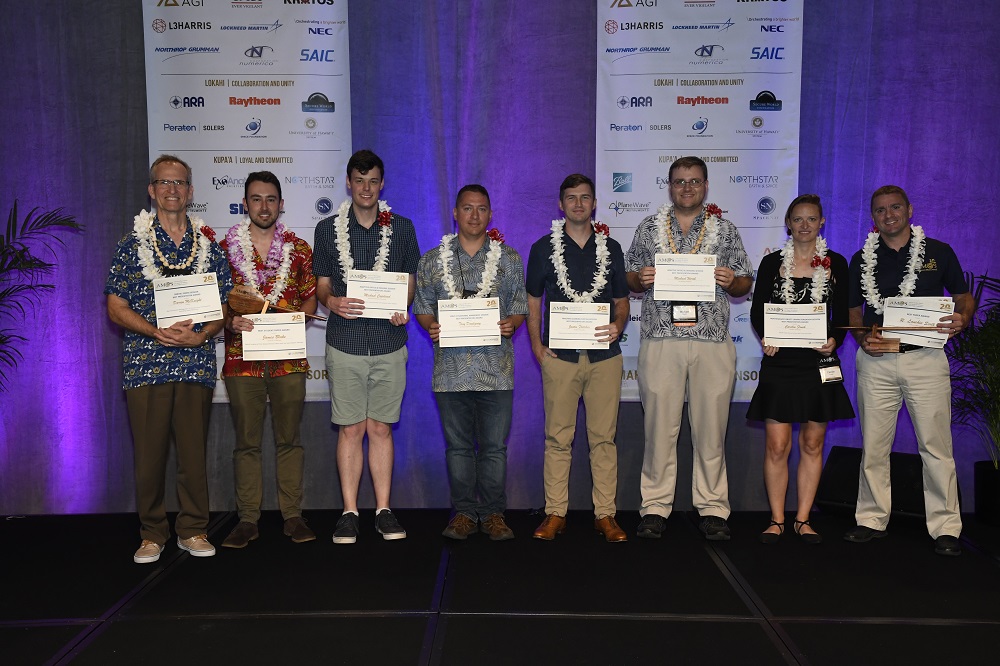
From L to R: Darren McKnight; James Blake,Michael Copeland; Troy Dotigney; Justin Fletcher; Michael Werth; Carolin Frueh; Lauchie Scott
AMOS 20th ANNIVERSARY: A MEMORABLE EVENT
The AMOS Conference began in 1999, as an Air Force Research Laboratory initiative executed by MEDB. At that time, the focus of the conference was to promote the AMOS site and facilities which have provided the U.S. DoD with SSA capabilities for over 65 years.
In 2006, MEDB assumed ownership of the AMOS Conference from the Air Force, and proceeded to build upon its early success by evaluating and adding elements to the conference that bring value to the SSA community. In the 13 years since, MEDB’s intent in presenting AMOS is still to support the Air Force’s mission on Maui which, in turn, supports MEDB’s mission of economic diversification.
“Celebrating the 20th Anniversary this year, we included some special AMOS moments and events to ensure a memorable conference,” said Leslie Wilkins, MEDB President and CEO. “We wanted to do something different to mark this important milestone. It was a wonderful opportunity to socialize and reminisce with the AMOS community, with special guest speakers and a memorable dinner to mark the occasion.”
Tamara Payne, Applied Optimization, said, “AMOS is a very important conference to me because I was part of the original group that developed, designed, and invented the conference with Paul Kervin, Sandy Ryan and others. It is the one place in the world that I can come to talk about the work that I do to protect all the important technology that we have in Earth orbit, and that helps keep us safe and secure in our daily lives. I believe Senator Inouye would be so proud of the wonderful women who run MEDB and how they have contributed to the growth of the AMOS Conference. AMOS is up there with the most professional conferences in the world. ”
“AMOS is such a great conference!” said Paul Graziani, AGI co-founder and CEO. “The content here is tremendous! It is focused on something that is very relevant to me. AGI also has the opportunity to show our corporate wares. Real decision makers are here, and the issues we talk about at AMOS produce real change. General Shelton is sitting in the audience. Kevin O’ Connell from the Department of Commerce gave a keynote on the last day. And, they make things happen here. For example, Col. Teehan laid out what he needs and the attendees will go back and work on it.”
“International cooperation is also key at AMOS.” continued Graziani. “Participation is very wide from other countries and we can share the responsibility with them to keep space safe and productive for all stakeholders and nations.”
Matt Hejduk, Astrorum Consulting has been coming to the AMOS Conference nearly every year since 2001. “Most conferences in technical disciplines direct their content either at professional researchers (the Ph.D. crowd) or the associated policymakers and governmental and industrial leaders.”
“AMOS is the rare, perhaps the only, conference that creates an integrated program of events useful and helpful to both groups, individually, as well as promoting their interaction,” Heyduk explained. “As both a research engineer and a program administrator, I can move seamlessly between technical papers in my discipline of interest to sidebar meetings with other administrators to create and advance collaborative arrangements among different government agencies or industry partners. If I were to attend only one conference each year, it would be the AMOS conference.”
David Bloyer, Deputy Maui Site Director for Boeing LTS, said, “Boeing has been supporting AMOS as a top sponsor for about 11 years and has been involved in some way since its beginnings. The local Maui group has a technical team here that really appreciates the opportunities of meeting like-minded people, explaining what we are capable of doing and producing, and we appreciate hearing the same from other attendees. The panel discussions are top-notch and the international community keeps growing in attendance as well. Overall, the chance to hear different techniques offered for SSA and STM, while interacting with the space community, comes together here. Congratulations to MEDB for their 20 years with the AMOS Conference. Their professionalism is extraordinary, providing the best conference experience while still maintaining its ohana (family) atmosphere and sense of place. The technical papers, poster sessions and all the opportunities they offer are representative of their growth.”
2019 Session Chair, Islam Hussein of L3-Harris who has been coming to AMOS for at least a dozen years or so. “Over the years, I saw the conference grow and my relationship with it and with the MEDB team evolve. Today, AMOS is a space pilgrimage of sorts and MEDB is a wonderful family that I am grateful to have in my life. I look forward to many more AMOS Conferences in my future.”
“I think that every year the AMOS Conference surprises me,” added Renato Zanetti, University of Texas,. “MEDB presents an extraordinary event. The Student Exploration Space Session and EMER-GEN for young professionals—events like this within AMOS add to what makes this conference so special. AMOS is the best networking conference as well, and I enjoy coming so much.”
Michael Czajkowski, Lockheed Martin, said, “The greatest thing about AMOS and MEDB is their ability to bring everyone in the SSA community together to discuss technical progress, to network, and to find interesting problems to work on together in the coming year. There is nothing quite like the AMOS Conference at any other time of the year, so if you are aspiring to be a part of this community, you need to come to AMOS!”
“The AMOS Conference is a great way to meet and mingle with others we don’t see all the time,” said Regina Peldszus, German Space Agency Department of SSA. “I get to hear different opinions, and discuss issues at the level of policy and technology operations for SSA.”
Maui-based Ron Viloria, a software consultant with PDS, A Centauri Company, said, “AMOS represents an exchange of ideas to me. MEDB participates in key projects that move Hawaii and Maui forward.”
SHORT COURSES
Technical Short Courses have been a feature of the AMOS Conference since 2014 providing opportunities for working professionals to upgrade their technical job skills and remain abreast of recent developments in their respective fields. This year there were nine courses.

Thomas Schildknecht, Astronomical Institute of the University of Bern, taught a short course on “Observing and Characterizing Space Debris” Particular focus was put on optical techniques to detect, track and characterize space objects including small-size debris
“AMOS offered a broad range of short courses available before the conference, ranging from topics on modeling and observing space debris to how to avoid it to machine learning and deep learning,” said T.S. Kelso, AGI. “I took the course on ‘SSA Optical Systems Modeling and Simulation” which gave attendees a comprehensive look at optical theory, considerations for how to build a model of an optical system, and ways to implement those models to support decision making. The course provided attendees with examples of how to make it easy to obtain relevant SSA data from their site. It was presented by experts in the field who answered questions about a wide range of issues”.
Virginia Wright, AFRL said, “I really appreciate the short courses preceding the AMOS Conference. I took a course on Demystifying Machine Learning (ML) and AI which gave me the opportunity to apply new techniques to SSA problems that have troubled us for a long time. The instructors specializing in SSA gave me the opportunity to get up to date on merging methods rapidly. The material is tailored to be especially relevant. SSA problems are challenging due to the number of objects in space, sparsity of data, and the timeliness we need to react to protect spacecraft. The ML class provided information that will allow us to leverage collected data to automatically produce predictive functions that are applicable to similar data.”
Wright added, “The information in this short course allows me to work on problems important to me in the future”.
Lieutenant Colonel Melissa Reyes, Canadian Armed Forces said, “Observing and Characterizing Space Debris, as presented by Thomas Schildknecht, provided a detailed review of the escalating space debris problem with suggestions on the way forward and how to mitigate it. It was made clear that international collaboration is essential for the fusion of globally-provided data in order to provide a current, complete and accurate space object debris catalogue to all involved nations. Overall, an excellent presentation that was well-respected, interesting, and informative.”
The regular conference program extended over three days, 18-20 September, each with keynote addresses and a policy forum, followed by technical sessions.
DAY 1
William Shelton, General, U.S. Air Force (retired), introduced the first speakers and set the tone for the entire conference:
“There are new threats and more traffic, all factors that can cause problems that have to be dealt with in space. We have gone from a peaceful domain to a challenging one. I hope over the next few days at AMOS we will find a safe path for the future and everybody can peacefully use space.”
He then introduced, in turn, Brigadier General Thomas L. James, Joint Space Task Force Commander, United States Space Command; and Major General John Shaw, Deputy Commander, Air Force Space Command. These speakers gave the military’s perspective on the role of space commerce and space diplomacy in national security, space situational awareness (SSA) and space traffic management (STM).
Brigadier General Thomas L. James, Joint Space Task Force Commander, USSPACECOM
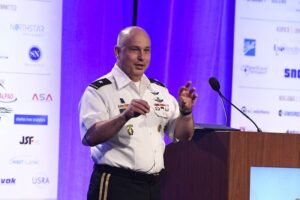
Brigadier General Thomas L. James, Joint Space Task Force Commander, USSPACECOM
General James opened by saying, “It is important to keep learning how to use space capabilities to impact our missions and how we live our lives. The Space Command environment is critical to our job. All want to have robust capabilities; however the U.S. is also determined to protect and defend our capabilities. At Space Command, we integrate capabilities and protecting our assets with the way we think about the space domain and how to prepare for conflict; changes in understanding threats leads us to a place of urgency. We rely on space domain awareness to protect against potential conflict.”
James added, “At this conference we need to think of how to develop and have a structure in place to determine a safe prosperous environment. And—we have to do both—develop strategic partnerships as well as countries with strong agreements. All sectors are important to how we strengthen these strategic partnerships. We want to look at space as a domain. Our mission statement is to deter conflict, but if there is conflict, we want to be in a position of strength. We hope that adversaries will see our strength and say, “not today”. Our job is to make sure that day of conflict never comes. Let economic growth continue, and through our strength and partnerships may we have success and a peaceful space domain.”
Major General John Shaw, Deputy Commander, Air Force Space Command
“Another tool in our toolkit is the rapid growth in space commerce,” pointed out General Shaw.”In other words, beyond those other very important missions, we need to also start thinking about improved SSA and STM as enablers of the growing global space economy and improved protection. Improving SSA and STM are key dependencies for the trillion-dollar space economy.”
Shaw continued, “SSA is a challenge that is growing. The International Space Station routinely gets warnings about collisions in LEO, and, as we continue space exploration out to the lunar spheres, that challenge remains. I think the answer is going to be a collective effort between the DoD and NASA, other departments both inside and outside of the US government, and also with our international partners. Industry is part of the solution and part of the responsibility in the space domain. As we move forward, the conversation will be driven by the potential and part of the understanding of transparency. To come together in the most effective way, we team with our allies in a global way to better understand what is going on in GEO. As we move forward, how will the US Space Force be part of that?”
Hirohisa Mori, Director, National Space Policy Secretariat, Cabinet Office, Japan

Hirohisa Mori, Director, National Space Policy Secretariat, Cabinet Office, Japan
The third keynote for Day 1 dealt with the future of launch and on-orbit safety. The address was given by Hirohisa Mori. His responsibilities cover policy, legal and international affairs related to Japans’ Self Defense Forces.
Mori said, “Our 2018 National Defense Program Guideline focuses on space as a new domain. It has become essential that Japan achieve superiority in new domains, which are space, cyber space, and electromagnetic spectrum. We wish to enhance cooperation with relevant agencies, including JAXA and the U.S. and other countries. Additionally, Self Defense Forces will engage in organization-building such as the creation of units specializing in space and dedicated fields, to develop human resources and accumulate knowledge and expertise in the space field.”
Mori added, “We also believe that space policy as a national strategy must contribute to the advancement of science and technology and to the hopes of the people. We must enhance the security of the people’s everyday lives, as well as improve our international industrial competitiveness. Considering all of this, we need to be careful with our limited national budget, and allocate our spending and future plans wisely and safely.”
Following the keynote, the SSA Policy Forum, presented in collaboration with Secure World Foundation, explored international issues related to SSA in a panel format. It brought together the developers and implementers of SSA capabilities and the architects of SSA policy to interact at a time when the landscape is rapidly changing.
SSA Policy Forum, Day 1: The Future of Launch and On-Orbit Safety
Imagine that the year is 2029. This panel discussed what the future of launch and on-orbit safety looks like, by examining how this system came to be, what challenges it needed to overcome, and what problems are still unresolved.
Andrew D’Uva, Providence Access Company, moderated the panel that looked ten years ahead at how the world’s civil and commercial STM system has developed as a consequence of U.S. and other policies, emerging capabilities, advances in scientific understanding, and rapid expansion of space use by commercial and civil actors. Panelists included Steph Earle, FAA; Walter Everetts, Iridium; T. S. Kelso, AGI; and Wasanchai Vongsantivanich, Geo-Information and Space Technology Development Agency (GISTDA).
Kelso said, “We are looking back on STM from 2029 and we have come a long way. STM is now thriving. At the turn of the 21st century, people actually thought we didn’t need to worry about STM, because space was a big place. However, we realized that STM is not geographically limited and that any accidents would affect the global space commons. That meant that STM was an international issue and an international organization was formed to manage data collection, quality control, analysis, and reporting. Satellite operators realized that STM was truly a collaborative effort and that individual operators or countries could not go it alone. We started openly sharing results with all operators in a collaborative fashion to ensure everyone had a common operating picture and could review all the data, as well. AI and quantum computing made assessing collision avoidance maneuvers substantially easier than back in the early days. Concepts like augmented reality, combined with ML, anticipated what an analyst wanted to see, making interacting with complex data systems intuitive and greatly facilitated. This collaboration helped decision makers understand their course of action, especially in exceptional cases.”
Kelso added, “So, don’t think because the ending will be good that there is not a lot of work to be done today to get us to 2029. That will take global collaboration and transparency and I’m confident that many of you in the audience today are prepared to work together and lead that effort.”
“The future generation of aviation will be efficient with shorter travel time,” predicted Steph Earle. “There will be less fuel needed, and more operators using reusability, a task that will contribute to more cost efficiency. There will be more space tourism with the expansion of the Space Force. I think there will be more balance in the interaction of all the modes of transportation, making traveling overall more cost efficient. Thanks to the space industry, the development of new ways of evaluating the risk of launching space vehicles will make space travel available to more people.”
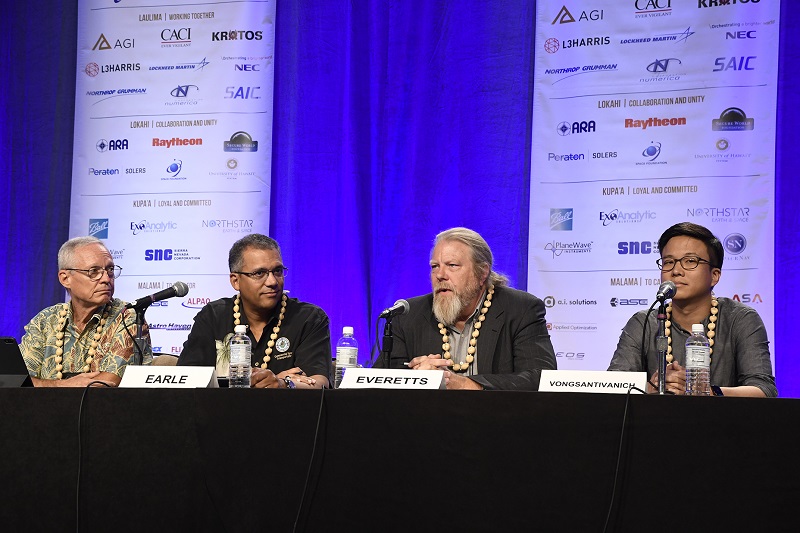
The SSA Policy Forum on Day 1 took a look at the future of launch and on-orbit safety
Everetts said, “In 2029 we will all be more responsible for our behavior in space. We will de-orbit vehicles out of necessity. We will be more transparent, making sure we communicate as best we can because we know that any risk affects operators worldwide. We will have a coordinated regulatory program and increased data sharing with SSA conversations being key to the industry. In 2029, what we are doing to maintain a safe, clean environment will be somewhat self-governing, although more policy may still be necessary to promote best practices.”
“Thailand is a newcomer in space,” said Vongsantivanchi. “However, as it is now, the need for the future of SSA and STM will grow even more. The general public will definitely be more involved in space travel and many more students will be doing SSA. We will have more modern methods of mitigating space debris and I see the public more involved in the future of the space industry and space travel.”
DAY 2
Keynote Address: Francesca Letizia, Space Debris Engineer, ESA
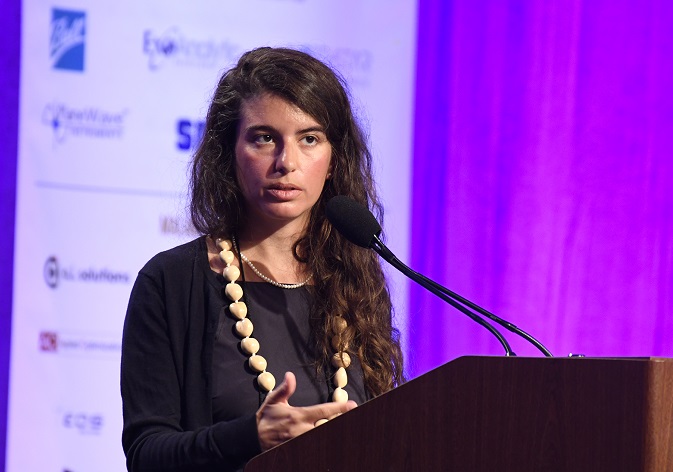
Francesca Letizia, Space Debris Engineer, ESA was the keynote speaker on Day 2 of the AMOS Conference
“My main tasks at ESA include the assessment of general compliance to space debris mitigation guidelines and the development of a metric for the contribution of a mission to the space debris environment,” said Letizia. “The number of launched spacecraft has grown in recent years. We are now tracking nearly 23,000 objects. Satellites are getting smaller and harder to track. Universities are building more of them, and commercial companies are shifting, using many little satellites to perform a mission.”
Letizia explained, “Some of the ways to manage space congestion include ensuring spacecraft do not explode and create extra debris. This is done by releasing all energy on board once a mission is completed. Another important aspect is, once a mission is finished, to be sure you leave the area where you are operating. For example, try to reenter toward the Earth so that new operators can go and use these orbits and you do not have the problem of the defunct satellites going around.”
“But countries are not always compliant, added Letizia. “While some satellites in LEO (Low Earth Orbit) will burn up on their own, others need help. There is room for improvement. On a positive note, over the last 20 years, the number of rocket bodies left in LEO has gone down.”
SSA Policy Forum, Day 2: SSA Data Sharing and Open Data Repositories
Moderated by Brian Weeden, the panel on Day 2 discussed the steps that stakeholders can take while mitigating collision risks in the space debris environment. The growing number of space actors and activities is driving increased demand for better quality SSA data and products. This in turn is creating interest in pooling different sources of data in ways that are openly accessible to many different users. Panelists included Chris Kunstadter, AXA XL; Diane Howard, Department of Commerce; Michael Nicolls, LeoLabs; Agnieszka Lukasccyk, Planet; and David Goldstein, SpaceX.
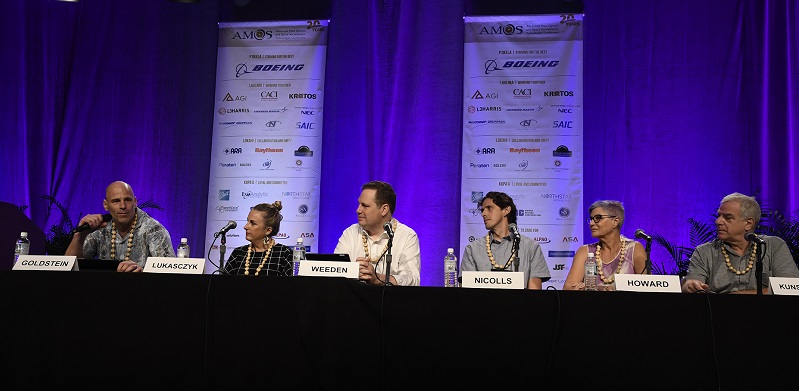
Brian Weeden of Secure World Foundation leads a panel discussion on SSA Data Sharing and Open Data Repositories
Weeden asked the panel, “In dealing with new challenges, like the number of objects in space and what that means for long-term sustainability, what steps can stakeholders take now?”
Lukasccyk said, “I strongly believe that international cooperation is crucial for the space sector to continue to grow. Planet wants to change the world with the work we are doing. We are conscious of the importance of sustainability and we take it seriously. Planet thinks we need more standards for best practices. For example, everyone should be responsible not to leave any debris in space. Space safety and security are global issues. At Planet, we share our data with everyone. We need to continue to build a network of responsible actors, such as the new Space Safety Coalition in which more than 20 organizations, including a number of major GEO and LEO satellite operators, have signed on to bring together major satellite operators to reduce the risks of collisions among the growing number of objects in orbit. Transparency is key.”
David Goldstein said, “SpaceX believes the space debris and STM are a global teamwork issue in the world of sustainability. We have to work together for all communities to continue to use space for peaceful purposes, to secure peace and economic benefit for all. Ability to increase sustainability by flying lower, aids in sustainability. We are committed to being highly transparent and working with other operators and organizations to ensure dating sharing. It is important to publish all of our covariance data and share predictions for collision avoidance.”
“We all need to shoulder our responsibilities so that we will launch astronauts to the Moon, Mars and beyond.” added Goldstein. “It is up to everyone to be transparent and collaborative so space can be used in the long term.”
Mike Nicolls stated that LeoLabs’ mission is to secure commercial operations in LEO. “As the LEO ecosystem around our planet gets more congested, the risk of collisions rises, and the need to map the orbits of spacecraft, satellites, and space debris grows with every launch. Meanwhile, new generations of commercial spacecraft, such as small and cube satellites, are causing a dramatic increase in imaging, communications, and human spaceflight prospects. The next major collision will be a catastrophe for everyone.”
Nicolls added, “LeoLabs was founded to provide access to critical mapping and SSA data for low Earth orbit (LEO) that address today’s risks. With a worldwide network of ground-based phased-array radars that enable high resolution data on objects in LEO, LeoLabs is uniquely equipped to offer data and services to mitigate the risks of collisions. These services include collision prevention, risk assessment, constellation monitoring, and SSA. LeoLabs serves space agencies, commercial satellite operators, defense, and scientific and academic organizations that are driving generational change in LEO. We are currently building the first small-debris space radar in New Zealand.”
Diane Howard contributed, “The Department of Commerce is providing space law expertise to the office of Space Commerce and the Department of Commerce as a whole. We are working on solutions to space environment challenges through a combination of law, policy, and engineering. An ongoing inter-agency review and update of U.S. orbital debris mitigation guidelines should be finalized relatively soon.”
Chris Kunstadter explained that space insurance includes technical, financial, actuarial analysis, and business development. “AXA is actively involved in all aspects of the space business including policy wording. We work closely with satellite operators and manufacturers, launch providers, and government agencies to enhance industry understanding of space risk management issues. I have personally served on numerous failure review boards for satellites and launch vehicles. Every satellite should have a beacon, a small piece of hardware that transmits a unique identifier, making it easier to track and identify satellites.”
DAY 3
Keynote Address: Kevin O’Connell, Director, U S. Office of Space Commerce
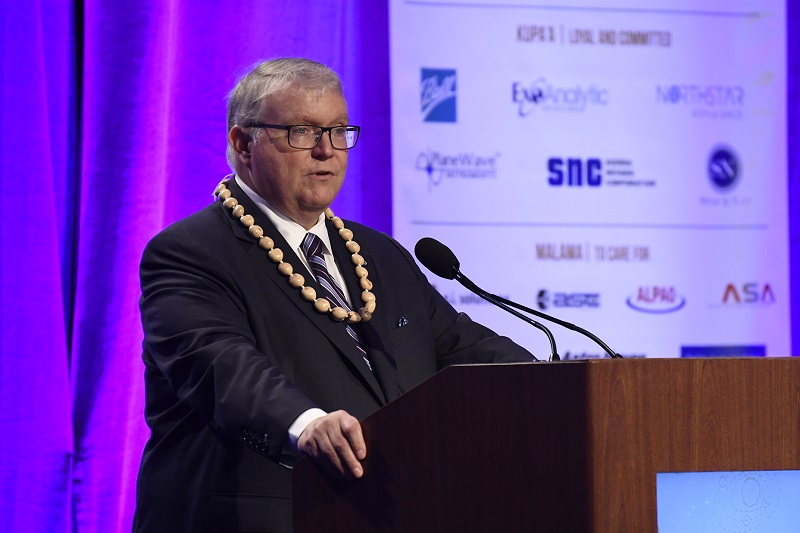
Kevin O’Connell, Director, U S. Office of Space Commerce addressed the AMOS audience on Day 3
Kevin O’Connell, Director of the Office of Space Commerce, one of the world’s foremost experts on the policy, security, and commercial issues of remote sensing technology, described 2020 as a building-block year as he looks to build-out the open-architecture data repository and develop an SSA marketplace for STM. For the last three decades, he has been intimately involved in identifying, analyzing, and managing emerging threats to the nation’s interests, governmental and commercial. Talking about the future of SSA support from the Office of Space Commerce, he provided an overview of his office’s efforts on STM, including plans to take over civil STM services by 2029.
O’Connell said, “The Office of Space Commerce needs an open-architecture data repository for SSA data. It is key to develop a more cooperative space business environment, encourage greater transparency and data sharing, and a wide range of sensors, analytic tools, and other capabilities designed to improve space safety and sustainability.
O’Connell added, “Satellite inspection and satellite servicing is an important next wave of space commerce. Improved SSA and STM will enable those capabilities, which potentially change the economics of space in fundamental ways. Developing the cislunar economy will require even a richer understanding of the space environment far beyond Low Earth Orbit.”
In closing, O’Connell said, “We hope to ultimately create conjunction notifications, based on the DoD authoritative catalog and a wide range of commercial and allied services. It will also serve as a marketplace for innovation among diverse providers of new SSA- and STM-related capabilities, with a view toward encouraging the development of a value-added market. We’re looking to continue to work with all of our partners for insights on how to create a truly modern SSA system that improves coordination in space.”
SSA Policy Forum, Day 2: Oversight of Satellite Constellations, Licensing and Norms
The growth in commercial space activities has sparked a growing number of governments to establish or modernize their existing licensing frameworks to provide oversight of private-sector space activities. At the same time, satellite operators are developing norms of behavior and best practices to demonstrate responsible behavior and influence regulations.
Moderated by Victoria Samson of Secure World Foundation, the panel discussed recent efforts to modernize licensing frameworks and develop best practices for large constellations, and the role for improved SSA. Also, how do you balance the public good against private interest and how do you balance commercial investment at the same time you write policy for space flight safety? Panelists included Diana McKissock, U.S. Air Force SSA Sharing & Spaceflight Safety Lead; Pascal Faucher, CNES; Mark Mulholland, Department of Commerce; Rogel Mari Sese, Philippine National Space Development Program and President, Regulus Spacetech, Inc.
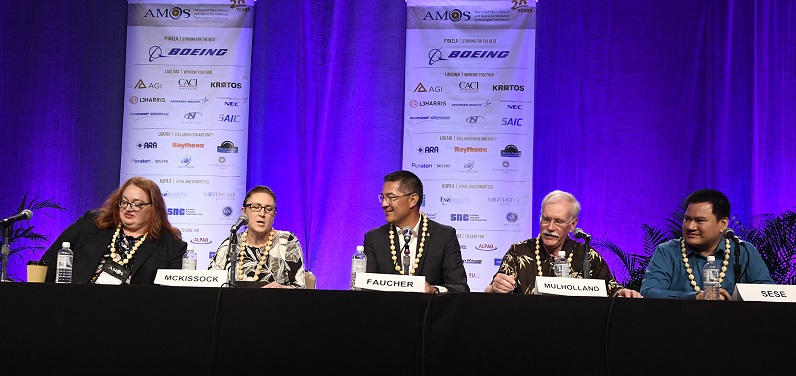
The Day 2 SSA Policy Forum discussed the oversight of satellite contellations, licensing and norms
Mulholland said, “The growing number of space actors and activities is driving increased demand for better quality SSA data and products. This in turn is creating interest in pooling different sources of data in ways that are openly accessible to many different users. The panel discussed the value of such open data repositories, what characteristics are essential for their success, and what challenges will need to be overcome in creating them and building trust with users.”
Taking a trip down memory lane, Mulholland gave a brief history of SSA data sharing−beginning with a definite negative to today’s environment of collaboration. He also reflected on parallels to the global weather forecasting enterprise.
Mulholland said, “Any company, big or small, can obtain access to the open meteorology architecture to take data they trust, to produce unique products and services that their customers trust. Individual people have access to finished forecast products as well. Isn’t this exactly what we’re trying to do today in the SSA and STM enterprise?”
McKissock said, “My job includes SSA sharing, launch conjunction assessment, human spaceflight support, and on-orbit spaceflight safety, all in support of USSTRATCOM’s SSA Sharing Program to deliver SSA data and services to the global space community. We maintain the space catalog, sharing the catalog and conjunction warnings for collision avoidance with all space actors.”
McKissock added, “I have the greatest job in the world because I get to give away free data. I receive many requests for data to help operators. In an ideal world, we would all trust each other; however, I believe we need to agree on standards concerning the decision to make a maneuver or not. There is an opportunity for industry and academia to fill the gaps for an essential system with open access. The challenges of tomorrow offer space providers a global marketplace. We hope to take the space industry to a whole new level.”
“SSA is global and must be shared.” said Faucher. “None of us can do this alone, so it is very timely to organize and network on solutions to the challenges we face today, such as what the increasing number of satellites, debris and space-faring nations mean for STM. We need key approaches to working with industry and setting requirements for future assets. The French launch capability within the ESA framework always looks towards the continual building of international collaboration in space.”
Sese added, “In the Philippines the space program is funded through the National Space Development Program. Early Philippine initiatives in space technology has been led by private firms although in the recent years the government has played a more active role. We have two primary challenges: insufficient funding and lack of a centralized agency to manage the space program. The National Space Development Program hopes to serve as the country’s primary strategic roadmap for space development and embody the country’s central goal of becoming a space-capable and space-faring nation in the next decade. Our long-term goal is to launch our own rockets as does NASA and JAXA.”
Day 3 Featured Presentation: Space Enterprise Acquisition
Colonel Russell Teehan, a Portfolio Architect for Air Force Space and Missile Systems Center gave a feature presentation on Friday afternoon. Col. Teehan’s talk, Shifting to an Enterprise Paradigm, expanded on several topics raised by keynote speakers during the conference. Space enterprise acquisition, national security strategy, and national strategy for space have placed a high priority on access to and operations in space. The significant increase in global space investment offers much opportunity for commercial entities and allies to offer capabilities.
Teehan explained, “As Portfolio Architect at Space and Missile Systems Center, I lead a team charged with spearheading the Center’s activities to design an integrated space enterprise architecture. We partner with allies, government agencies and our industry partners to enable the Center to smartly design, rapidly acquire, and expeditiously integrate the weapon systems needed to support today’s fight and the battlefield of tomorrow. We need space enterprise capability for acquisition needs. Data is the major element of the architecture. The goal is integrative strategies with our allies for General Raymond.”
Day 2 Keynote speaker, Francesca Letizia, summed up the experience at the 2019 AMOS Conference “AMOS is a great conference! I was exposed to different fields than I work in at the conference, which was so interesting. I saw how things are changing in every sector of the space enterprise which was an added value of the conference for me. The first-hand perspectives and interactions with the international community are priceless. How we are contributing to these efforts geographically, and through the different sectors that are involved, is key to the future of space.”
